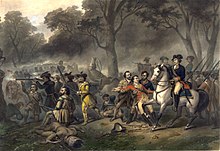
Back معركة مونونغاهيلا Arabic Mononqahela döyüşü Azerbaijani Битка при Мононгахела Bulgarian Bitva u Monongahely Czech Schlacht am Monongahela German Monongahelan taistelu Finnish Bataille de la Monongahela French Monongahelai csata Hungarian Battaglia del Monongahela Italian Slag bij Monongahela Dutch
| Battle of the Monongahela | |||||||
|---|---|---|---|---|---|---|---|
| Part of the French and Indian War | |||||||
 Washington the Soldier by Reǵnier (1834), depicting Lt. Col. Washington on horseback during the battle | |||||||
| |||||||
| Belligerents | |||||||
|
Ottawas Abenaki Lenni Lenape Hurons Potawatomis Ojibwa |
| ||||||
| Commanders and leaders | |||||||
|
|
| ||||||
| Strength | |||||||
|
637 First Nations (the Ottawas, Ojibwa and Potawatomis) 108 troupes de la Marine 146 militia[2] Total: 891 | 1,300 regulars and provincial troops.[2] | ||||||
| Casualties and losses | |||||||
|
39 killed 57 wounded[3][4] |
457 killed[5][2] 450+ wounded[6] | ||||||
The Battle of the Monongahela (also known as the Battle of Braddock's Field and the Battle of the Wilderness) took place on July 9, 1755, at the beginning of the French and Indian War at Braddock's Field in present-day Braddock, Pennsylvania, 10 miles (16 km) east of Pittsburgh. A British force under General Edward Braddock, moving to take Fort Duquesne, was defeated by a force of French and Canadian troops under Captain Daniel Liénard de Beaujeu with its American Indian allies.
The defeat marked the end of the Braddock Expedition, by which the British had hoped to capture Fort Duquesne and gain control of the strategic Ohio Country. Both Braddock and Beaujeu were killed in action during the battle. Braddock was mortally wounded in the fight and died during the retreat near present-day Uniontown, Pennsylvania. He specifically asked for George Washington, who accompanied him on the march, to oversee his burial. The remainder of the British column retreated south-eastwards. Fort Duquesne and the surrounding region remained in French hands until its capture in 1758.
- ^ "The Battle of the Monongahela". World Digital Library. 1755. Retrieved August 3, 2013.
- ^ a b c Borneman p. 55
- ^ Borneman p. 55 – French: 28 killed 28 wounded, Indian: 11 killed 29 wounded
- ^ Preston 2015 p. 270
- ^ Preston 2015 p. 276
- ^ Frank A. Cassell. "The Braddock Expedition of 1755: Catastrophe in the Wilderness". Archived from the original on June 7, 2010.